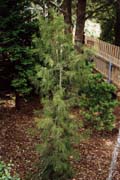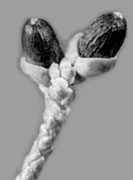Conservation Status

Manoao colensoi
(Hook.) Molloy 1995
Common names
Manoao [Maori], silver pine (Molloy 1995), Westland pine, white silver pine (Dallimore et al. 1967).
Taxonomic notes
The sole species in Manoao Molloy 1995. Syn: Dacrydium colensoi Hooker 1843, D. westlandicum T. Kirk 1877, Lagarostrobos colensoi Quinn 1982 (Quinn 1982, Molloy 1995). Although Quinn's extensive revisions to the genus Dacrydium have been generally accepted by the taxonomic community in Australia and New Zealand, certain characters clearly distinguished the Huon pine (Lagarostrobos franklinii) from the Manoao even in Quinn's review, and these differences have been added to by results of subsequent studies of leaf flavonoid profiles, leaf cuticular morphology, and cone morphology and pollination mechanisms (cited in Molloy (1995)). Briefly, the two species can be distinguished on the basis of numerous characters vegetative, reproductive, and chemical; and these differences are comparable in magnitude and number to those used to discriminate the other Dacrydium-like genera (Dacrydium, Falcatifolium, Halocarpus, Lagarostrobos and Lepidothamnus). Moreover, "Lagarostrobos franklinii and L. colensoi can be distinguished readily on the character-states of the female cone, the traditional basis for the recognition of genera within the Podocarpaceae" (Molloy 1995).
Named for (and collected by?) the pioneering New Zealand botanist William Colenso, by his good friend J.D. Hooker (Salmon 1996).
Description
A tree up to 15 m tall and 100 cm dbh, with a straight, clear trunk and slender branchlets. In its younger stages the silver pine is a cone-shaped tree but later develops a tall, moderately spreading crown. Bark is bark brown-grey. There are three distinct growth stages, each defined by the foliage. In the juvenile tree the leaves are 6-12 mm long, narrow, pointed, subterete, rather limp and spreading, and with distinct bands of stomata on their undersurfaces. As the plant reaches the semi-adult stage, the leaves are smaller, 3-4.5 mm long, subfalcate, flattened and arranged in two opposite rows in the same plane. The leaves of the adult tree are 1-2.5 mm. long, thick, coriaceous, keeled and scale-like, appressed to the branchlets in four rows with ultimate branchlets c. 1.5 mm in diameter. Pollen cones are solitary, terminal, 3-5 mm long, c. 1.5 mm. wide. Ovules solitary or paired, terminal, final scale leaves thin, rather lax, spreading; epimatium transversely keeled, about 1/3-1/2 length of seed, which is 2-4 mm long, broadly ovoid-oblong, black (Allan 1961, Dallimore et al. 1967, Salmon 1996). (A much lengthier description is available in Molloy (1995)). See García Esteban et al. (2004) for a detailed characterization of the wood anatomy.
Manoao is often confused with Halocarpus biformis, which differs in the juvenile foliage and stouter branchlets (Dallimore et al. 1967).
Distribution and Ecology
New Zealand: North and South Islands, from sea level to an altitude of about 950 m. Within its range, mean annual temperature is 11.1°C, with an average minimum in the coldest month of -1.4°C, and a mean annual precipitation of 3744 mm (Biffin et al. 2011, Table S5). Hardy to Zone 8 (cold hardiness limit between -12.1°C and -6.7°C) (Bannister and Neuner 2001).
The species is confined to high-rainfall districts from North Cape to South Westland and Lake Te Anau, but is notably absent from large parts of the North Island, eastern South Island, Fiordland, and Stewart Island. Plants of M. colensoi occur in shady situations with rich soil in a wet climate. Usually it is found on older, poorly drained surfaces with leached infertile soils, and in acid swamps and peats, notably the 'pakihi' lands of western South Island. It grows very slowly (Molloy 1995, Salmon 1996).
Remarkable Specimens
The oldest known living specimen, 574 years, was documented in a tree-ring chronology covering the period 1403-1976 (crossdated after 1410), collected near the Grey River on New Zealand's south island by Peter Dunwiddie (doi.org/10.25921/ydsk-sn24). Dunwiddie also did a collection on Mt. Ruapehu on the north island, finding a tree at least 499 years old (doi.org/10.25921/vf8j-h724). More recently, Claude Grayson (email 2023.04.05) provided me a photo of a subfossil cross-section with about 330 rings. No other collections have been recorded, and considerably older specimens may exist.
Ethnobotany
See Conifers of New Zealand for a review of the historic role of forests in native and European cultures of New Zealand.
"Kirk describes the wood as straight and even in the grain, dense, firm, and compact, yet of low specific gravity; of great strength, toughness, and elasticity, shrinking little when seasoning, and taking a high polish. Mottled wood is highly prized for cabinets and furniture" (Dallimore et al. 1967). Before the arrival of the English, it was recognized by the Maori as exceptionally durable wood, and used accordingly (Molloy 1995).
Manoao has seen limited research use in a few dendroclimatic studies (e.g., Norton & Palmer 1992).
Observations
Silver pine is said to be very common on the South Island (Trevor Hinchliffe e-mail, 2003.02.20), and on the North Island in the forests on the Ohakune side of Mt Ruapehu, at c. 1,000 m elevation (Salmon 1996).
Remarks
The species was more widespread in the Pleistocene, especially in wetlands of Northland, South Auckland and Taranaki (Molloy 1995).
This species is capable of reproduction by suckering (extension of underground stems). In waterlogged soils, the underground stems and roots contain aerenchyma (Molloy 1995), an adaptation to anoxic soil conditions that is also found in Taxodium and perhaps in other wetland-site conifers.
Trunks of this species "carry a heavy burden of lichens, mosses and liverworts whose fidelity and host-specificity are largely unknown. Silver pine also supports a ubiquitous fungal flora, especially sooty mould, and an insect fauna that includes undescribed gall-forming mites (Arectis sp.), scale insects (Eriochiton sp., Leucaspis sp.), and Lepidoptera (Orthenches sp.)" (Molloy 1995).
Citations
Allan, H. H. 1961. Flora of New Zealand. Volume I, Indigenous Tracheophyta. Wellington: R.E. Owen Government Printer.
See also
Hooker. 1843. Ic. Pl., t.548, not t.544.
Keng Hsuan. 1979. A Monography of the genus Phyllocladus (Coniferae). Natural Publishing Company, Taipei, Taiwan, 113 pages, black-and-white photographs, line drawings, maps, bibliographies.
Kirk, T. 1877. A revised Arrangement of the New Zealand Species of Dacrydium, with Descriptions of new Species. Transactions and Proceedings of the Royal Society of New Zealand 10:383-391 (as Dacrydium westlandicum; accessed 2011.03.27).
Kirk (1889) (as Dacrydium westlandicum).
Gymnosperms of New Zealand.
Search for information on this species at the New Zealand Plant Conservation Network.




